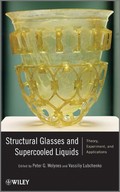Structural Glasses and Supercooled Liquids
Theory, Experiment, and Applications

1. Edition April 2012
416 Pages, Hardcover
Wiley & Sons Ltd
Short Description
Although glass has been manufactured and used for millennia, the understanding that the mechanism of their formation is distinct from that of the more common polycrystalline arrived only a few decades ago. The stakes are high as glassy and related disordered materials form some of the most economically important materials in such key technologies as data storage. With contributions from 24 global experts of diverse disciplines, this landmark book presents researchers with a modern, complete survey of glassy phenomena in many systems, based on firmly established characteristics of underlying molecular motion.
With contributions from 24 global experts in diverse fields, and edited by world-recognized leaders in physical chemistry, chemical physics and biophysics, Structural Glasses and Supercooled Liquids: Theory, Experiment, and Applications presents a modern, complete survey of glassy phenomena in many systems based on firmly established characteristics of the underlying molecular motions as deduced by first principle theoretical calculations, or with direct/single-molecule experimental techniques. A well-rounded view of a variety of disordered systems where cooperative phenomena, which are epitomized by supercooled liquids, take place is provided. These systems include structural glasses and supercooled liquids, polymers, complex liquids, protein conformational dynamics, and strongly interacting electron systems with quenched/self-generated disorder.
Detailed calculations and reasoned arguments closely corresponding with experimental data are included, making the book accessible to an educated non-expert reader.
Contributors xi
1 Supercooled Liquid Dynamics: Advances and Challenges 1
Ranko Richert
2 The Random First-Order Transition Theory of Glasses: A Critical Assessment 31
Giulio Biroli and Jean-Philippe Bouchaud
3 Dielectric Spectroscopy of Glassy Dynamics 115
P. Lunkenheimer, M. K¨ohler, S. Kastner, and A. Loidl
4 Glasses and Replicas 151
Marc M´ezard and Giorgio Parisi
5 Glassiness in Uniformly Frustrated Systems 193
M. Dzero, J. Schmalian, and Peter G. Wolynes
6 Random First-Order Phase Transition Theory of the Structural Glass Transition 223
T. R. Kirkpatrick and D. Thirumalai
7 Fragile Glass Formers: Evidence for a New Paradigm, and a New Relation to Strong Liquids 237
C. Austen Angell
8 Dynamics in the Crossover Region of Supercooled Liquids 279
Biman Bagchi
9 Glassy Dynamics of Proteins 319
Guo Chen, P. W. Fenimore, and Hans Frauenfelder
10 Theories of Structural Glass Dynamics: Mosaics, Jamming, and All That 341
Vassiliy Lubchenko and Peter G. Wolynes
Index 381
Vassiliy Lubchenko, PhD, is an Associate Professor of Chemistry at the University of Houston. A recipient of the Beckman Young Investigator Award and Sloan Research Fellowship, Dr. Lubchenko researches optoelectronic anomalies of amorphous materials, dynamics of complex fluids and structural glasses, and aggregation behaviors in protein solutions.


